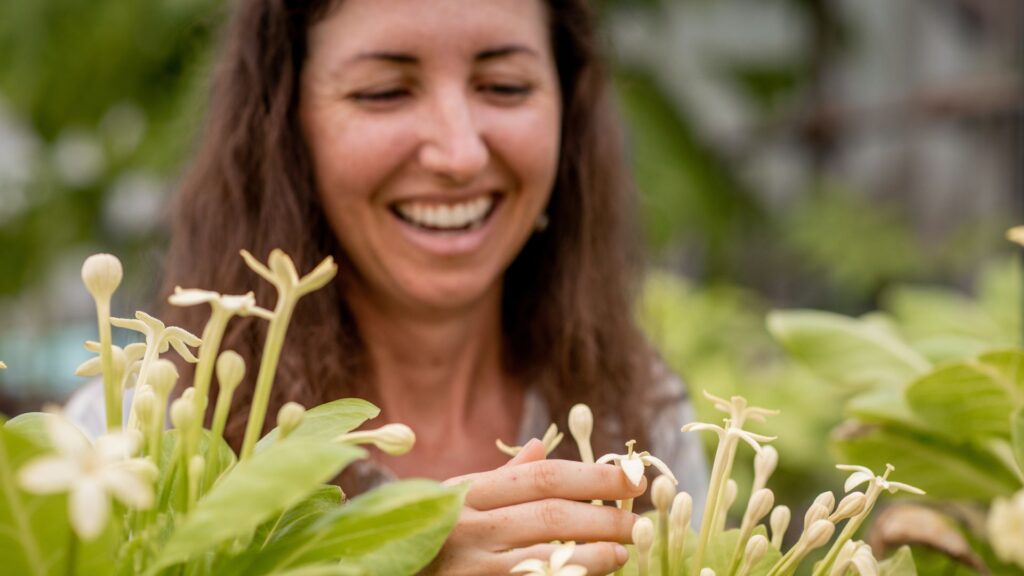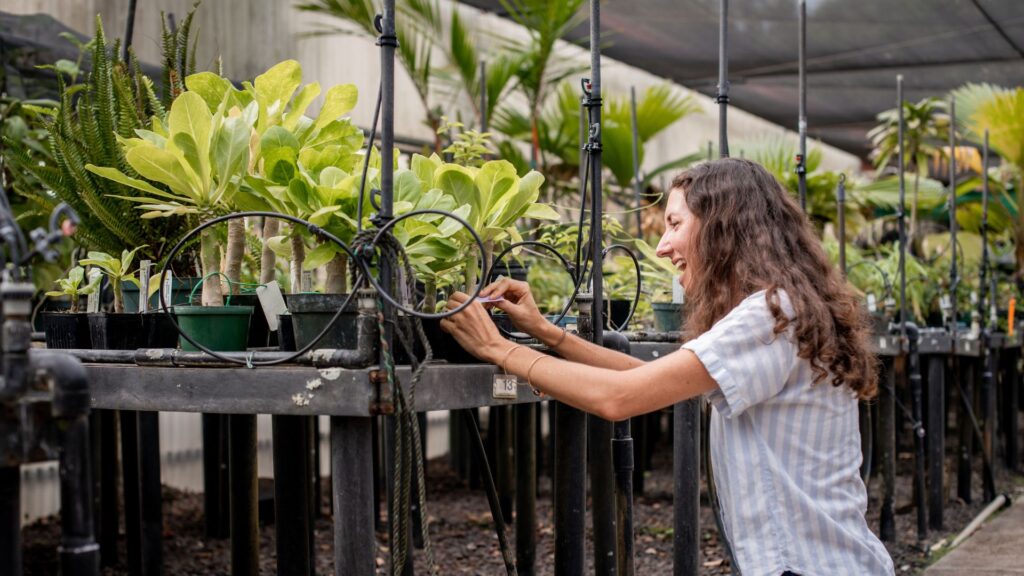People need plants. They are the root cause of our health, habitat, and happiness. More than ever, plants need you. Join us this fall as we explore how cultivating deeper connections with plants can grow a brighter tomorrow for our ecosystems and communities.
Where are you at this moment? Whether you’re surrounded by wildlife or citylife, you’re in a habitat that is alive with relationships. Species and soil, climate and community, wind and water are working together to make life possible. A Hawaiian proverb reads I ola ‘oe, i ola mākou nei. “My life is dependent on yours, your life is dependent on mine.” Everything in your habitat is intimately connected.
(L) Uma Nagendra admires an ohia lehua. (R) A rock islet in Palau photographed on a recent expedition by Ken Wood
In many ways, plants are the threads that weave this tapestry together. They stitch together entire food webs and provide a patchwork of so many other necessities, down to the very air we breathe. However, in a rapidly changing world, plants and plant communities are disappearing. Each plant lost is a thread cut from this vibrant tapestry, an end to a network of relationships and a potentially reshaped habitat. To restore habitats, it’s vital to rethread them with their unique plants that are a support system for the life they sustain.

Uma Nagendra inspects the beautiful flowers of kokio keokeo (Hibiscus waimeae subsp. hannerae)
At this moment, there is a good chance that Uma Nagendra is in the habitats of Limahuli Garden & Preserve. As the Conservation Operations Manager there, she works to understand and restore Hawaiian ecosystems in the face of constant change. Limahuli on Kauai is considered one of the most biodiverse valleys in Hawaii. To perpetuate the environmental integrity of this invaluable place, Uma relies on plants. “Plants are the foundation of nearly every ecosystem – they don’t just enhance the ecosystem, they create it!” shares Uma. “Here in Hawaii, ohia and other montane trees capture mist from the clouds and gather raindrops, forming the cloud forest that feeds all the rest of Hawaiian streams. Their nectar feeds the forest birds; their bark houses mosses, insects, and snails; their roots shelter seabird burrows.”
Limahuli Garden and Preserve totals over 1,000 acres and are managed within an ahupuaa framework, continuing a living legacy of indigenous stewardship. Ahupuaa are Hawaiian land divisions that extend from mauka (mountain) to makai (ocean). Within this framework, humanity and nature are inseparable. The same water that condenses atop the highest ohia in the ahupuaa makes its way through misty falls and mesic forests, through loi kalo (taro terraces) and rushing streams out into a bustling reef. At every section of the ahupuaa, plants sustain life for the ecosystem and community alike.
On a daily basis, Uma experiences the biodiversity that plants make possible in Limahuli’s preserves: Tiny land snails sneaking by on haha (Cyanea spp.) leaves, pueo owls in courtship, Tetragnatha spiders in “full arachnid-yoga poses,” apapane birds diving across the ohia canopy, the barking sounds of ao (Newell’s shearwater), hundreds of opae kuahiwi (mountain shrimp) darting in the stream. All of these precious residents of Limahuli depend on the ahupuaa’s native plants. Without them, Limahuli wouldn’t be the same. “A forest in Hawaii dominated by invasive guava will feel completely different from a diverse ohia forest,” says Uma. “In the ohia forest, you’ll see a wider variety of textures and layers, you’ll feel the moisture hanging in the air, you’ll feel the spongy moss cover beneath your feet, perhaps you’ll even hear more birds and other animals enjoying the trees. Because plants are the foundation for everything else, it truly matters which plants are the ones building that foundation.”
“We can all do our part to make sure our habitats have the support system they need.”
Uma Nagendra, Conservation Operations Manager
Uma and her team work to safeguard and restore the habitats of Limahuli. You can help be the support system for the habitat you call home. “We can all do our part to make sure our habitats have the support system they need by limiting the impact of existing invasive plants, animals, and microbes; avoiding introducing new ones when we enter wild places; and not exacerbating climate change.” Find out what invasive species are impacting your habitat and what native plants share your home. Building awareness and knowledge about the plants that define your habitat is a great step towards caring for the special place you live.
To help us root more deeply into the habitats that support us, Uma recommends a recurring meditation. “Find a quiet moment where you can observe your outdoor surroundings. It doesn’t matter if you’re in an urban environment, rural, suburban, or wilderness – all of these are ecosystems. Try for 15 seconds of stillness, then observe with as many senses as you can. Do you hear or see any animals or plants? What textures, air currents, warmth, or precipitation is present? Repeat the exercise weekly. Can you notice when the seasons begin to change? What animals and plants are active or migrating at different times of the year? Does the air feel different to you as the months roll on?”

Seana Walsh admires alula (Brighamia insignis) flowers at NTBG’s Conservation Nursery
Seana Walsh, NTBG’s Conservation Biologist, has been growing a brighter tomorrow for the beloved alula (Brighamia insignis) for over seven years. While extinct in the wild, these charismatic plants that once adorned sea cliffs on Kauai and Niihau have made their way across the world in botanical garden collections and as indoor houseplants. Seana is leading a cutting-edge study to strategically breed these cultivated alula to enhance diversity and plant health. While this strategy has been used in zoos for decades, this major undertaking is one of the first of its kind for plants. Seana’s work with alula is perpetuating a beloved plant for Hawaii. At the same time, she is helping to develop and inform strategies for perpetuating plants—and the habitats they sustain— across the world.
(L) Alula (Brighamia insignis) in bloom. (R) A Molokai alula (Brighamia rockii) at home on a sea cliff
For Seana, bringing plants back from the edge of extinction is a moral obligation. She grew up on the leeward side of Maui, where invasive species and degraded landscapes provided a stark comparison to the native plants and habitats she now nurtures. “Knowing what I know now, and what I experience during my time and work in the forest, it is very clear how different a healthy, native forest both looks and feels compared to one dominated by non-native species,” Seana says. “In a healthy native forest, you won’t see large areas of bare soil or pooling water. Non-native forests with exposed earth cause runoff when it rains and pools of water which are breeding grounds for mosquitoes, a huge threat to our native forest birds. A native forest results in less runoff which equates to more groundwater recharge and less sediments flowing downstream and covering our reefs.”

Kampong by Christina Pettersson
Healthy habitats and communities rely on plants. By tuning in to the habitats we call home and the plants that define them, we can learn how to be a support system for the places we love.
Plants nourish our ecosystems and communities in countless ways. When we care for plants, they continue caring for us. Help us grow a brighter tomorrow for tropical plants.